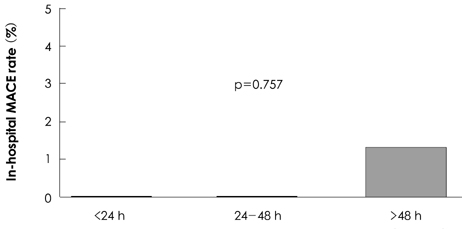Korean Circ J.
2008 Jan;38(1):23-28. 10.4070/kcj.2008.38.1.23.
Prognosis According to the Timing of Percutaneous Coronary Intervention in an Acute Non-ST Segment Elevation Myocardial Infarction
- Affiliations
-
- 1Division of Cardiology, Department of Internal Medicine, College of Medicine, Pusan National University, Busan, Korea. md-phd@hanmail.net
- KMID: 2225870
- DOI: http://doi.org/10.4070/kcj.2008.38.1.23
Abstract
- BACKGROUND AND OBJECTIVES
An early invasive strategy with coronary angiography and revascularization is currently the recommended treatment for patients at high risk with an acute non-ST-segment elevation myocardial infarction (NSTEMI). In this early invasive strategy, percutaneous coronary intervention (PCI) is generally recommended within 48 hours, but there is little data on earlier intervention in intermediate risk patients.
SUBJECTS AND METHODS
We studied retrospectively the past medical records of 118 patients at intermediate risk that were admitted at Pusan National University Hospital and were stratified by the time interval from chest pain onset to PCI (Group I: <24 hr; Group II: 24-48 h; Group III: >48 h). Clinical outcomes were evaluated in terms of in-hospital and 12 months follow-up of a major adverse cardiac event (MACE).
RESULTS
Baseline characteristics were not different statistically among the three groups, except for the use of tirofiban. There were no in-hospital deaths or myocardial infarctions (MI) in Group I and Group II patients, but there were three cases of in-hospital deaths in Group III patients. The incidence of a 12-month MACE was 0% in Group I patients, 6.7% (one revascularization) in Group II patients and 17.1% (3 deaths, 3 MIs, 7 revascularizations) in Group III patients (p=0.043).
CONCLUSION
In acute NSTEMI, the incidence of a 12-month MACE was lower in the intermediate risk group when PCI was performed in the early period. Early PCI could be recommended in acute NSTEMI on the basis of the status of individual patients.
MeSH Terms
Figure
Reference
-
1. Bertrand ME, Simoons ML, Fox KA, et al. Management of acute coronary syndromes in patients presenting without persistent ST-segment elevation. Eur Heart J. 2002. 23:1809–1840.2. Braunwald E, Antman EM, Beasley JW, et al. ACC/AHA 2002 guideline update for the management of patients with unstable angina and non-ST-segment elevation myocardial infarction-summary article: a report of the American College of Cardiology/American Heart Association task force on practice guidelines (Committee on the Management of Patients With Unstable Angina). J Am Coll Cardiol. 2002. 40:1366–1374.3. Fragmin and Fast Revascularization During InStability in Coronary artery disease Investigators. Invasive compared with non-invasive treatment in unstable coronary-artery disease: FRISC-II prospective randomized multicenter study. Lancet. 1999. 354:708–715.4. Wallentin L, Lagerqvist B, Husted S, Kontny F, Stahle E, Swahn E. Outcome at 1 year after an invasive compared with a non-invasive strategy in unstable coronary-artery disease. Lancet. 2000. 356:9–16.5. Lagerqvist B, Husted S, Kontny F, et al. A long-term perspective on the protective effects of an early invasive strategy in unstable coronary artery disease: two-year follow-up of the FRISC-II invasive study. J Am Coll Cardiol. 2002. 40:1902–1914.6. Cannon CP, Weintraub WS, Demopoulos LA, et al. Comparison of early invasive and conservative strategies in patients with unstable coronary syndromes treated with the glycoprotein IIb/IIIa inhibitor tirofiban. N Engl J Med. 2001. 344:1879–1887.7. Diderholm E, Andren B, Frostfeldt G, et al. The prognostic and therapeutic implications of increased Troponin T levels and ST depression in unstable coronary artery disease. Am Heart J. 2002. 143:760–767.8. Lagerqvist B, Diderholm E, Lindahl B, et al. The FRISC score for selection of patients for an early invasive treatment strategy in unstable coronary artery disease. Heart. 2005. 91:1047–1052.9. Schiller NB, Shah PM, Crawford M, et al. Recommendations for quantification of the left ventricle by two dimensional echocardiography. J Am Soc Echocardiogr. 1989. 2:358–367.10. Quinones MA, Waggoner AD, Reduto LA, et al. A new simplified and accurate method for determining ejection fraction with two dimensional echocardiography. Circulation. 1981. 64:744–753.11. Antman EM, Cohen M, Bernink PJ, et al. The TIMI risk score for unstable angina/non-ST elevation MI: a method for prognostication and therapeutic decision making. JAMA. 2000. 284:835–842.12. Grech ED, Ramsdale DR. Acute coronary syndrome: unstable angina and non-ST segment elevation myocardial infarction. BMJ. 2003. 326:1259–1261.13. Fox KA, Poole-Wilson PA, Henderson RA, et al. Interventional versus conservative treatment for patients with unstable angina or non-ST-elevation myocardial infarction. Lancet. 2002. 360:743–751.14. Boden WE, O'Rourke RA, Crawford MH, et al. Outcomes in patients with acute non-Q-wave myocardial infarction randomly assigned to an invasive as compared with a conservative management strategy. N Engl J Med. 1998. 338:1785–1792.15. Neumann FJ, Kastrati A, Pogatsa-Murray G, et al. Evaluation of prolonged antithrombotic pretreatment ("cooling-off" strategy) before intervention in patients with unstable coronary syndromes: a randomized controlled trial. JAMA. 2003. 290:1593–1599.16. Yeghiazarians Y, Braunstein JB, Askari A, Stone PH. Unstable angina pectoris. N Engl J Med. 2000. 342:101–114.17. Boden WE. "Routine invasive" versus "selective invasive" approaches to non-ST-segment elevation acute coronary syndromes management in the post-stent/platelet inhibition era. J Am Coll Cardiol. 2003. 41:113S–122S.18. Jeong JH, Chun KJ, Park YH, et al. The safty of tirofiban therapy in patients with acute coronary syndrome. Korean Circ J. 2004. 34:558–564.19. Park DW, Park SW. Stent thrombosis in the era of the drug-eluting stent. Korean Circ J. 2005. 35:791–794.
- Full Text Links
- Actions
-
Cited
- CITED
-
- Close
- Share
- Similar articles
-
- Missing Right Coronary Artery in a Patient with Acute Inferior ST Segment Elevation Myocardial Infarction: A Case of Extremely Rare Variation of Coronary Anatomy
- Differences in Clinical Outcomes Between Patients With ST-Elevation Versus Non-ST-Elevation Acute Myocardial Infarction in Korea
- Acute Myocardial Infarction by Right Coronary Artery Occlusion Presenting as Precordial ST Elevation on Electrocardiography
- ST segment
- Current Status of Coronary Intervention in Patients with ST-Segment Elevation Myocardial Infarction and Multivessel Coronary Artery Disease



